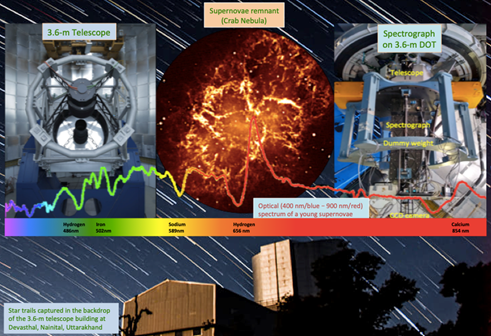
In News –Indian Scientists have indigenously developed a low-cost optical spectrograph .
About
- The optical spectrograph named as Aries-Devasthal Faint Object Spectrograph & Camera (ADFOSC), indigenously designed and developed by Aryabhatta Research Institute of observational sciences (ARIES), Nainital, an autonomous institute of Department of Science and Technology (DST).
- The spectroscope is the largest of its kind among the existing astronomical spectrographs in the country, has been successfully commissioned on the 3.6-m Devasthal Optical Telescope (DOT)
- It is about 2.5 times less costly compared to the imported ones and can locate sources of light with a photon-rate as low as about 1 photon per second.
- The total cost of this instrument is nearly Rs. 4 Crore.
Features –
- This instrument is a backbone of the 3.6-m DOT for observations of extremely faint celestial sources, uses a complex arrangement of several lenses made of special glasses, polished to better smoothness to produce sharp images of the celestial sky.
- Photons coming from distant celestial sources, collected by the telescope, are sorted into different colors by the spectrograph and are finally converted into electronic recordable signals using an in-house developed Charge-Coupled Device (CCD) camera cooled to an extremely low temperature of -1200C.
Significance –
- The indigenous efforts to build complex instruments like ADFOSC in India is an important step to become ‘Aatmanirbhar’ in the field of astronomy & astrophysics.
Present Usage –
- The spectrograph is presently being used by astronomers from India and abroad to study distant quasars and galaxies in a very young universe, regions around supermassive black-holes ,the galaxies, cosmic explosions like supernovae and highly energetic Gamma-ray bursts, young and massive stars, and faint dwarf galaxies.

- This collage shows pictures of the 3.6-m Devasthal Optical Telescope (DOT), the ‘Made-in-India’ ARIES-Devasthal Faint Object Spectrograph & Camera (ADFOSC), and an image of celestial source obtained from the telescope.
|
Devasthal Optical Telescope
|
Previous article
Extradition
Next article
Lavender brings profit for Doda farmers